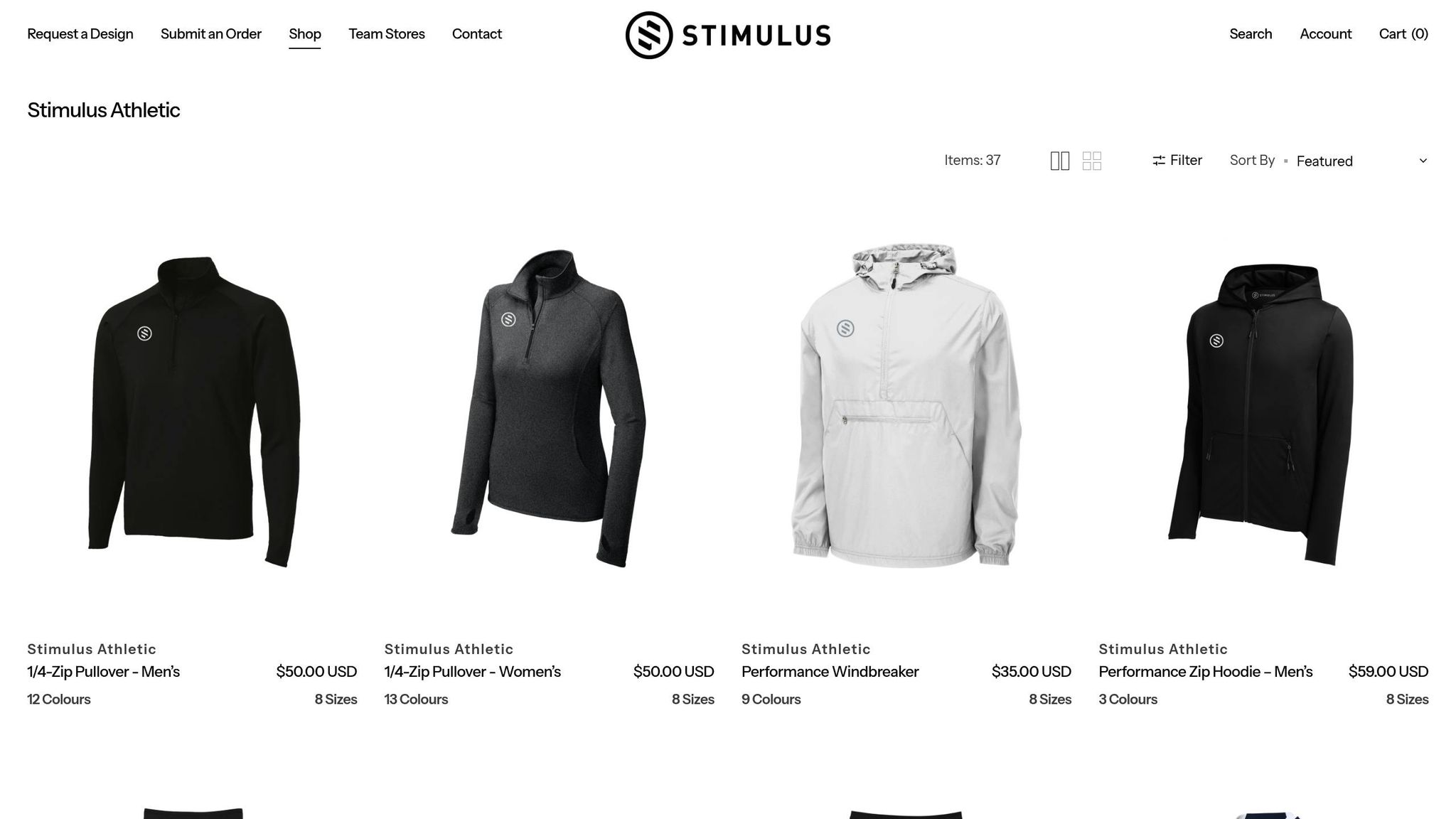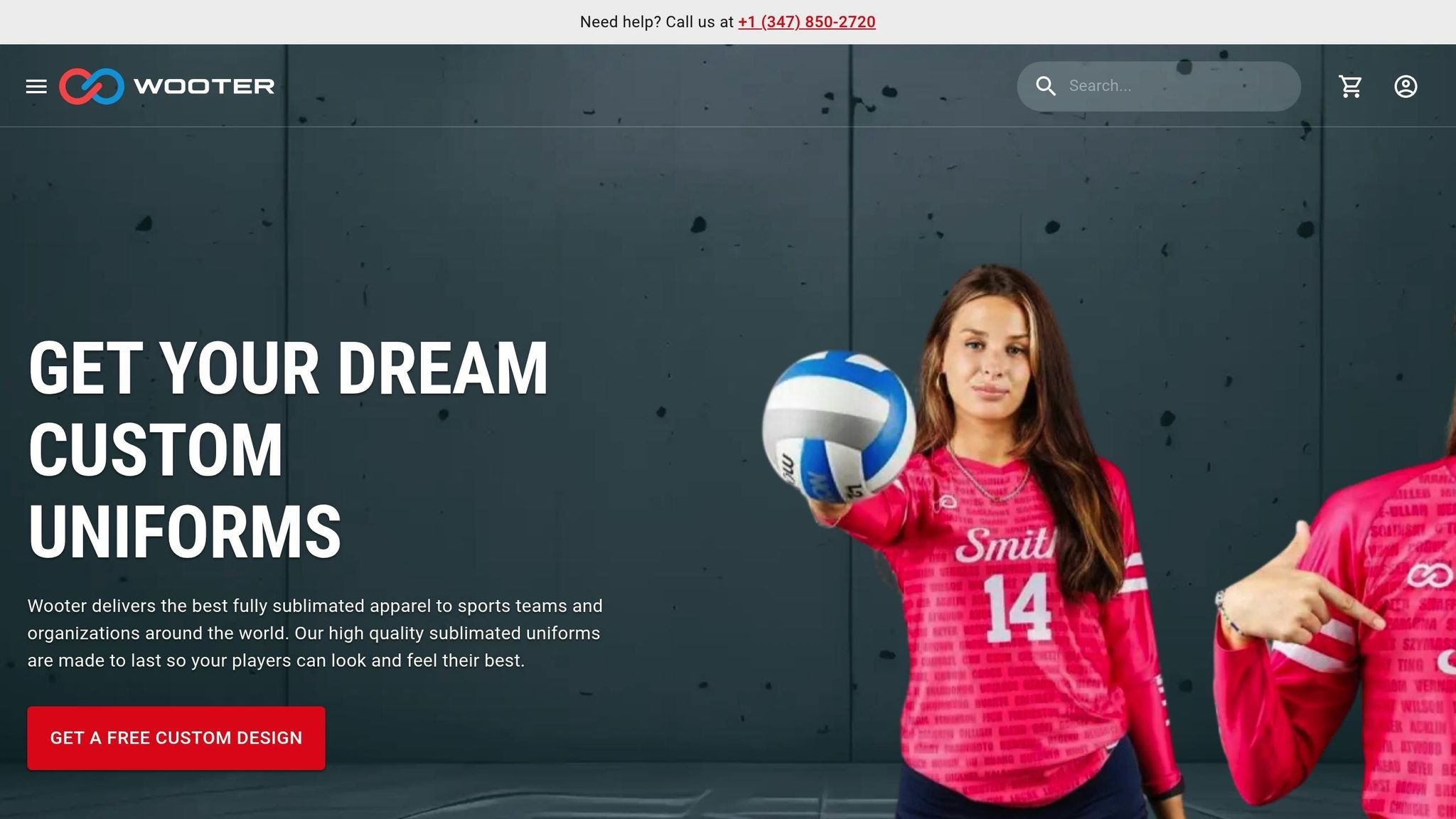Getting the right fit for team uniforms isn’t just about looks – it’s about performance, comfort, and durability. Properly fitted uniforms allow players to move freely, stay comfortable, and focus on the game without distractions. Here’s what you need to know:
- Accurate measurements: Measure chest, waist, hips, inseam, and sleeve length for each player. Double-check measurements to avoid errors.
- Size charts: Always refer to the manufacturer’s specific size chart as sizes vary across brands.
- Fit styles by sport: Basketball needs freedom for movement, soccer benefits from slim fits, and football varies by position.
- Fabric choices: Opt for moisture-wicking polyester or blends for durability and comfort. Avoid cotton, which absorbs moisture and fades quickly.
- Weather considerations: Lightweight fabrics for hot weather, heavier options for cold, and mesh for breathability in humid conditions.
- Youth and gender-specific fits: Account for growth in youth teams and choose gender-specific cuts for better fit and comfort.
Key tip: Start early, stay organized, and partner with experienced uniform providers like Wooter Apparel to simplify the process and ensure your team looks and feels great on game day.
How to Find Your Perfect Uniform Fit | Stimulus Athletic Sizing Guide!

Taking Accurate Team Measurements
Getting measurements wrong can lead to discomfort and poor performance, while accurate measurements ensure players can move freely and look sharp. The secret lies in using the right tools, following consistent techniques, and recording everything carefully.
Required Measurements for Uniforms
To properly size team uniforms, you’ll need five key measurements: chest, waist, hips, inseam, and sleeve length. Each plays a vital role in ensuring a good fit across various uniform pieces.
- Chest measurements: Measure around the fullest part of the chest, just under the armpits, keeping the tape snug but allowing one finger to fit underneath. This ensures jerseys fit well without restricting arm movement.
- Waist measurements: Taken at the natural waistline – the narrowest part of the torso – this helps size shorts, pants, and determines how jerseys will drape. For athletic wear, measure where the waistband naturally sits during activity.
- Hip measurements: Measure around the fullest part of the hips to ensure shorts and pants allow for unrestricted movement during running, jumping, or quick changes in direction.
- Inseam measurements: Measure from the crotch seam to the desired length of the shorts or pants. For shorts, this is typically 5–9 inches, depending on the sport and personal preference. For pants, measure to the intended hem length.
- Sleeve length: Measure from the shoulder point to the desired sleeve end. This varies by sport and style, ranging from cap sleeves to full-length arms.
Use a flexible measuring tape; stiff tools like rulers or metal tapes won’t contour to the body properly. Have the person being measured wear lightweight, form-fitting clothing or underwear to avoid inflated measurements. Make sure they stand naturally, arms at their sides, without holding their breath or tensing up.
Always measure each area twice to minimize errors. If there’s a discrepancy, take the average. Whenever possible, have someone else handle the measurements for greater precision.
Once you’ve gathered accurate measurements, the next step is understanding how to use size charts effectively.
How to Read Size Charts
After taking measurements, size charts help translate those numbers into the right uniform sizes. Since sizing varies between manufacturers, never assume sizes are consistent across brands. For example, a medium jersey from one supplier might fit like a large from another.
Most size charts for the U.S. market display measurements in inches. Look for charts that differentiate between body measurements (the player’s actual dimensions) and garment measurements (the finished uniform’s dimensions).
Pay attention to the fit style noted on the chart. Athletic cuts are generally slimmer, while loose fits allow more room for movement. Some charts also indicate the ease, or extra space, built into each size.
When selecting sizes, compare all relevant measurements. For instance, a player might fit a medium for chest size but need a large for waist size. In such cases, consider the sport’s demands – basketball players might prioritize chest room for arm movement, while runners might focus on waist comfort.
Uniform pieces often have separate sizing requirements. A player might wear a medium jersey but need large shorts due to hip and waist measurements. For teams ordering multiple items, create a sizing matrix to track each player’s size across jerseys, shorts, warmups, and accessories. This reduces errors and ensures consistency.
Measuring Different Age Groups and Genders
While the core measurements remain the same, adjustments are often needed for different age groups and genders.
- Youth players: Since kids grow quickly, take measurements as close to the order date as possible. Youth bodies often have shorter torsos and relatively longer sleeves compared to adults. Order slightly larger sizes to allow for growth, but avoid oversizing to maintain safety and comfort. A good rule of thumb is to add 1–2 inches to chest and waist measurements.
- Female athletes: Women’s uniforms typically require narrower shoulders, longer torsos, and different waist-to-hip ratios. Many manufacturers offer gender-specific cuts for better fit and comfort. When measuring, focus on both bust (fullest part of the chest) and chest (just under the bust) measurements, as both impact fit and movement.
- Male athletes: Men’s uniforms often account for broader shoulders and shorter torsos relative to height. They generally need more room in the chest and shoulders but less length in the torso compared to women of the same height.
For mixed-gender teams, choose suppliers that offer both men’s and women’s cuts in the same style. This ensures everyone gets a proper fit instead of compromising with a one-size-fits-all approach.
To maintain consistency, develop a clear measurement guide with photos or videos to ensure everyone uses the same techniques. Recheck sizes annually or biannually, especially for youth teams or players with fluctuating body sizes.
Finally, consider the sport’s specific needs. Basketball uniforms may need a looser fit for arm movement, while soccer uniforms often require a more streamlined fit to prevent grabbing. If standard sizes don’t work, explore custom sizing options to adjust sleeve length, inseam, or torso fit for players who fall between sizes.
Selecting Fit Style and Fabric
Once you’ve nailed down precise measurements, the next step in customizing uniforms is choosing the right fit style and fabric. These decisions aren’t just about aesthetics – they directly impact performance. The wrong combination can restrict movement, trap heat, or wear out too quickly. On the flip side, the right choices can make a noticeable difference in how athletes perform and feel on the field or court.
Fit Styles by Sport Type
Each sport comes with its own set of physical demands, and the fit of a uniform should support those specific requirements. Here’s a breakdown of what works best for different sports:
- Basketball uniforms: These typically feature a standard or relaxed fit. Players need freedom for shooting, jumping, and lateral movements. Shorts usually have a 9-11 inch inseam and a loose fit around the hips and thighs, allowing for deep squats and lunges.
- Football uniforms: Fit varies by position. Skill players often prefer fitted cuts to reduce fabric grabbing, while linemen need relaxed fits to accommodate padding. Sleeves should be snug enough to prevent opponents from grabbing but loose enough for shoulder pad mobility.
- Soccer uniforms: Athletic or slim fits are ideal, as they reduce wind resistance and prevent opponents from grabbing loose fabric. A streamlined design supports speed and agility without limiting range of motion, while shorts should allow unrestricted leg movement for kicks and sprints.
- Baseball and softball uniforms: These tend to have standard to relaxed fits, giving players the flexibility needed for throwing, batting, and fielding. Jerseys should provide extra room in the shoulders and torso for swinging motions, while pants need to handle sliding without restricting movement.
- Track and field uniforms: Streamlined cuts are key to reducing air resistance and avoiding excess fabric that could interfere with precise movements. However, athletes in field events, like shot put, may opt for slightly looser fits to maximize their range of motion.
Youth teams often benefit from slightly looser fits to allow for growth, while competitive adult teams may prioritize fitted styles that enhance performance.
Fabric Types and Performance
After selecting the right fit, the choice of fabric plays a crucial role in how the uniform performs. Modern materials offer significant advantages over traditional options, and understanding these differences helps you make informed decisions.
- 100% polyester: Known for its moisture-wicking properties, quick-drying capabilities, and shape retention, polyester is a go-to choice. It also works well with sublimated designs, preserving color vibrancy and resisting shrinking or fading.
- Polyester mesh: This fabric combines the durability of polyester with added breathability. Its open weave allows for better airflow, making it perfect for high-intensity sports or hot climates. Mesh panels are especially useful in areas like the back or underarms.
- Moisture-wicking blends: By mixing polyester with small amounts of spandex or elastane (5-10%), these fabrics provide stretch and flexibility while maintaining moisture management. They’re ideal for sports requiring dynamic movements.
- Antimicrobial treatments: While not mandatory, these are helpful for teams with limited uniforms or frequent practices, as they reduce odor and bacteria buildup.
Avoid using cotton or cotton blends for athletic uniforms. Cotton absorbs moisture, becomes heavy during activity, and fades or shrinks unpredictably. Fabric weight also matters – lighter fabrics (4-6 oz per square yard) are great for warm weather, while heavier options (6-8 oz per square yard) offer more durability and opacity, especially for lighter-colored uniforms.
Weather and Care Factors
Climate and maintenance needs should guide your fabric and style choices. Teams playing in various conditions will require uniforms tailored to their environment.
- Hot weather (above 80°F): Go for lightweight, breathable fabrics with moisture-wicking properties. Mesh panels or full mesh designs improve ventilation. Lighter colors reflect heat better, though team colors and league rules may limit options.
- Cold weather (below 50°F): Slightly heavier fabrics offer insulation while maintaining moisture-wicking capabilities. Long-sleeve options and layering pieces can help, but avoid fabrics that stiffen in the cold, as they can restrict movement.
- Humid conditions: Maximum moisture-wicking fabrics are essential here. Look for materials specifically designed for high humidity, which often feature enhanced wicking treatments.
- Indoor vs. outdoor: Indoor teams can use lighter fabrics since weather isn’t a factor, while outdoor teams need durable materials that can handle sun exposure and fluctuating conditions.
Proper care also extends the life of uniforms. Wash them in cold water (below 80°F) and avoid fabric softeners, which can damage moisture-wicking properties. Air drying is best, but if using a dryer, stick to low heat to prevent shrinking or melting. For sublimated uniforms, steer clear of bleach and harsh detergents.
Teams that wash uniforms frequently need fabrics that can withstand repeated cycles without losing quality. For schools or organizations with limited laundry facilities, antimicrobial and quick-drying fabrics can be a practical choice.
Finally, budget plays a role. While premium fabrics offer top-tier performance, standard polyester provides a reliable, cost-effective option for recreational teams. The key is to match the fabric to your team’s specific needs rather than simply opting for the most expensive choice.
sbb-itb-4d95ad3
Fixing Common Fit Problems
Choosing the right measurements and fabric is just the start – tackling fit issues quickly is key to getting the best performance from your uniforms. Even with careful planning, problems can pop up. Spotting them early and knowing how to fix them makes all the difference. Let’s dive into some common fit problems and how to handle them.
Common Fit Issues and Solutions
Some of the most frequent issues include sleeves that are too long or short, waistbands that don’t sit right, or an overall length that’s off. Small tweaks can often be handled by a local tailor, but if the problem is more severe, it might point to a sizing mistake. Keeping a detailed record of each player’s measurements alongside uniform specifications can help you spot patterns and prevent future issues.
Maintaining Consistency Across the Team
To ensure everyone’s uniforms fit consistently, stick to a standardized measuring process. Assign one person to take measurements using a reliable, non-stretch tape, and double-check all critical numbers. Create a size chart that includes each player’s name, position, and measurements. This way, you can quickly address any mismatches and easily adjust for roster changes. By staying organized, you’ll save time and reduce headaches down the line.
Engaging with Customization Services
If fit problems show up after delivery, don’t wait – reach out to Wooter Apparel’s support team right away. Send them clear photos and order details within 30 days to get the ball rolling on a resolution. A design consultation before ordering can also help avoid surprises. With a 4.9-star rating from 1,237 reviews, Wooter Apparel is known for its customer service and quality. Keep track of all your communications, design approvals, and measurements to make the process smoother if issues arise.
Getting the Perfect Custom Uniform Fit
Achieving the perfect fit for your team uniforms involves more than just picking sizes off a chart. It’s about precise measurements, smart fabric choices, and timely adjustments. When you combine these elements, you’ll have uniforms that not only look sharp but also help your team perform at their best. Here’s how to bring it all together.
Key Fit Guidelines
To ensure your uniforms fit like a glove, start with accurate and consistent measurements. Use a non-stretch measuring tape, and have one trained person take all the measurements to maintain consistency. For youth teams, it’s a good idea to add an extra inch to allow for growth.
Next, choose a fit style that aligns with your sport’s specific needs. Outdoor sports in warm climates, for example, benefit from moisture-wicking fabrics to keep players cool, while indoor sports might prioritize durability over breathability. Always consider the environment where the uniforms will be used.
Keep things organized by recording each player’s measurements in a spreadsheet. This not only simplifies reordering but also helps you identify sizing trends across the team. Taking reference photos of how the uniforms should fit can also be a handy tool for future orders.
If fit issues arise, address them right away. Small tweaks, like adjusting sleeve lengths, can often be done locally, but bigger problems, like major sizing discrepancies, may require professional tailoring.
Simplifying Your Order with Wooter Apparel

Once you’ve nailed the basics, teaming up with experts can make the process even smoother. Wooter Apparel offers free custom design services and fully sublimated uniforms that are built to last. Their sizing system works across multiple sports, so whether you need uniforms for basketball, football, baseball, softball, or soccer, you’ll have a consistent and straightforward process.
For example, their Custom Basketball Team Uniform Package – MVP is priced at $199.99 and includes jerseys, shorts, and warmups, giving your team a polished, cohesive look. If you prefer to purchase individual items, you can get Custom V-Neck Basketball Jerseys or Custom Basketball Shorts for just $16.99 each. This flexibility allows you to mix and match based on your needs and budget.
Another big advantage? There’s no minimum order requirement. Whether you’re outfitting a full roster or just replacing a few pieces, you can order exactly what you need. This is especially helpful for youth leagues, where team sizes can change frequently. With these options, achieving the perfect fit has never been easier.
FAQs
What’s the best way to take accurate and consistent measurements for custom team uniforms?
To ensure team uniforms fit perfectly, start by using a soft, flexible measuring tape. Have the player stand straight and relaxed, and take measurements over snug, form-fitting clothing. Always record the measurements in inches to keep things consistent. Pay attention to key areas like the chest, waist, hips, and inseam, making sure the tape stays level and snug without being too tight.
For accuracy, measure each player individually and double-check your results to catch any mistakes. Consistency is crucial – measure the same specific points on every person and document everything clearly. This approach helps guarantee a great fit for every uniform.
What should I consider when selecting the best fabric for team uniforms in different weather conditions?
When choosing fabric for team uniforms, it’s crucial to think about the weather your team will encounter. In hot conditions, go for lightweight, breathable, and moisture-wicking fabrics like polyester or performance blends. These materials help keep players cool and dry by allowing airflow and managing sweat effectively.
For colder climates, look for insulating options such as fleece or wool blends. These fabrics retain warmth while still pulling moisture away from the skin, ensuring players stay comfortable without feeling damp.
Selecting the right fabric can make a big difference in keeping your team comfortable and ready to perform, no matter the weather.
What should I do if my team’s uniforms don’t fit as expected?
If your team’s uniforms aren’t fitting as they should, contact the supplier immediately to explore options like adjustments, exchanges, or replacements. Most suppliers are prepared to help you sort out these issues efficiently.
To prevent sizing problems down the line, make sure to take precise measurements before placing your order. Carefully review the manufacturer’s sizing guide and factor in any specific fit preferences your team might have. These steps can go a long way in ensuring everyone gets the right fit.

